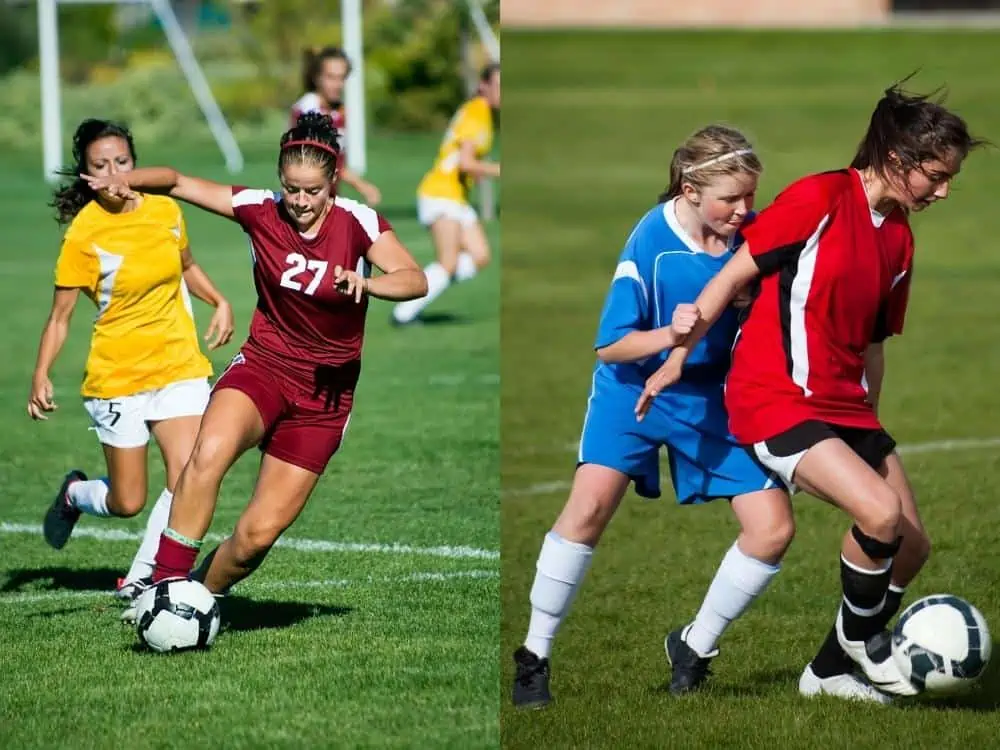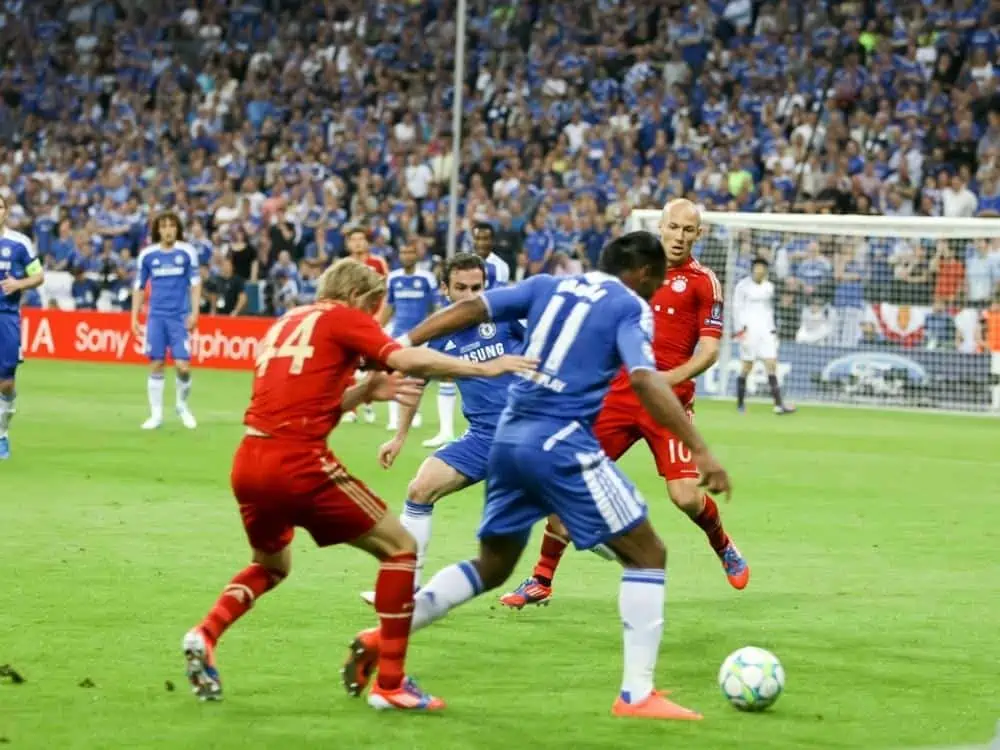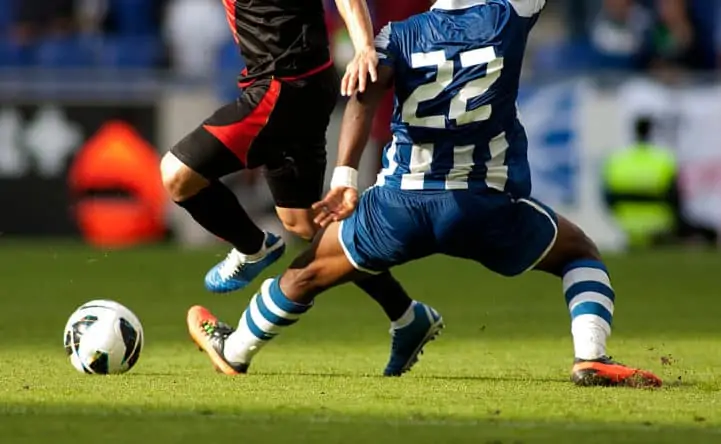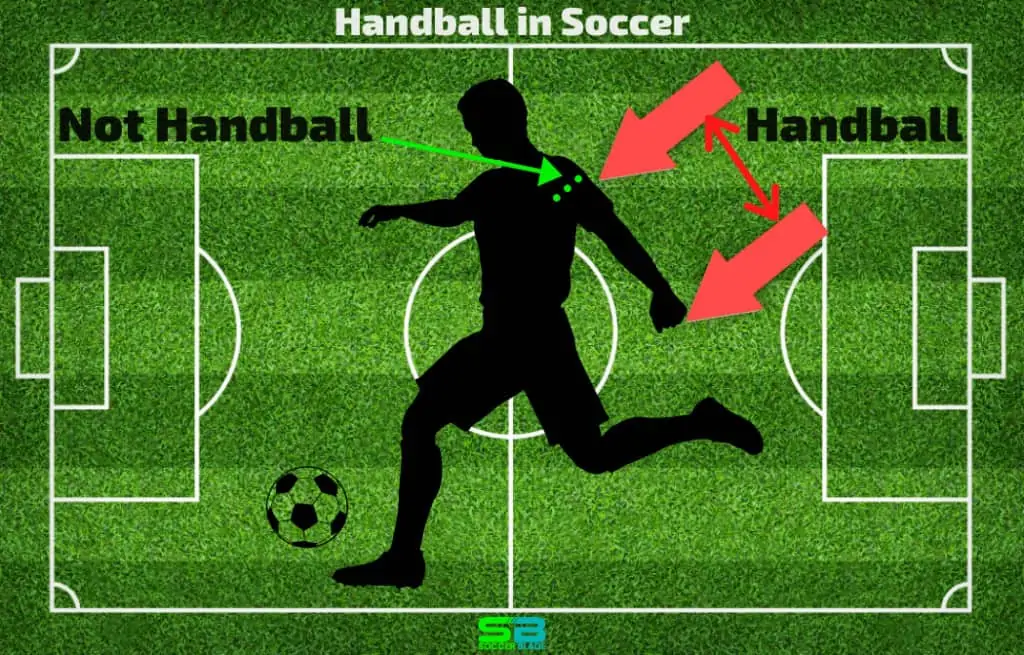Share the post "Can You Use Your Arms in Soccer? (Rules + Tips)"
In soccer, you can use your arms in certain situations. But outfield players can’t use their arms to touch the ball and control it.
Here are some of the most important rules I’ll take through, plus some other tricks in the game;
- Using your hands
- Arms
- Elbows
So, let’s look at ways soccer players can and can’t use their arms in soccer.

- When you can use your arms in soccer
- When You Can’t Use Your Arms in Soccer
- Can You Push in Soccer?
- Using Your Arm to Defend Can Be Acceptable
- Use Your Arms to Keep Close to an Opponent
- Balance Your Body with Your Arms
- Utilize Your Arms to Run Better
- Let Your Teammates Know You Want the Ball Using Your Arms
- Can You Use Your Shoulder in Soccer?
- Can You Use Your Elbows in Soccer?
- Can You Use Your Hands in Soccer?
- Why Can’t You Use Your Hands in Soccer?
When you can use your arms in soccer
- To defend – you can use your arms to shield the ball. (The video below will show you how)
- To communicate – let your teammates know you want the ball by using your arms.
- For balance – you can put your arms out to help you balance.
- To jump – it’s difficult to jump high without using your arms. Just be careful with your elbows.
- To run – ever see a soccer player running without using their arms? Didn’t think so.
- If you’re a goalie – this means you can use your arms inside your 18-yard box.
When You Can’t Use Your Arms in Soccer
- To touch the ball – outfield players can’t touch the ball with their arms.
- To push – see the next section.
- To grab a player or their shirt – the referee will give a foul.
- To protect your face – if you raise your arm to protect your face from the ball, the referee will give a foul if the ball touches your arm.
Can You Push in Soccer?
No, you can’t push in soccer. If a referee thinks one player pushed another, she’ll give a foul against the offending player.
That means pushing is a foul in soccer.
But what is considered a push in soccer?
Here’s the deal, there’s an obvious push and a not-so-obvious push. And the referee must decide on whether to give a foul or not.
- A push in the back with outstretched arms is an obvious push. If the referee sees a push in the back, they’ll always give a foul.
But there are times when a push is less obvious. For example, check out the video below:
As we see, the push in the example is less obvious. The assistant on the touchline helps the referee and waves for a foul.
So, the referee and assistants must decide if one player pushed another. But once a push is called, it’ll always be a foul.
According to soccer rules;
If a player pushes another one in a way that the referee thinks is reckless, careless, or employing excessive force, the referee has the right to give a direct free-kick to the pushed player’s team.
If you want to avoid giving your team a free kick or receiving a yellow or red card, never use your arms as a means to push another player. You can, however, slightly press the other player by leaning into them with your shoulder to protect the ball.
That is regarded as legal, but be careful, as some referees will consider it a foul if your opponent falls or takes a dive.
Using Your Arm to Defend Can Be Acceptable
According to soccer rules, it is legal to defend using your hands and arms, as long as you don’t use them to stop the ball. To protect the ball or the goal, you’re allowed to shield it from another player using your arm or body by leaning into another player.
If you intend to defend the ball, you must not allow your arm to contact it. Being able to use your arms in this manner is crucial to being a competent soccer player. You can practice this skill with a friend if you have the chance!
While you’re allowed to use your arms for defense, you’re not allowed to push another player away by sticking your arm out. Players in other sports like rugby can often hold their arms out or stiff-arm another player to keep them at arm’s length.
There is no such thing as a “stiff arm in soccer.” It’s against the rules and is dangerous behavior.
Don’t Hold Another Player
If you want to hold or touch another player, you have to do this with extreme caution, as the referee can judge that you used reckless, careless, or excessive force and consider it a foul.
The referee decides many things in the game, and they use their understanding and experience to make decisions on the field. In soccer, it’s not acceptable to grab another player because it’s a foul.
A referee will issue a warning to the offending player or even give them a card.
Use Your Arms to Keep Close to an Opponent
During soccer games, players frequently use their arms to keep themselves close to another player. When players from for a set-piece like a free-kick or a corner kick, the defending team’s players frequently use their hands and arms to hold or touch the player, they’re marking.
Most teams assign a specific player from their team to track or mark a player from the opposing team at a set-piece. This eliminates any uncertainty among players who are keeping an eye on whom.
At the same time as monitoring the opposing players, the defenders should keep an eye on the rest of the field and be aware of their surroundings.
Defenders frequently place their hands on the person they are marking to ensure the opposing player doesn’t get away while looking around the soccer field. Touching enables them to follow them and know where they’re moving without looking.
Balance Your Body with Your Arms
In soccer, you need to have the ability to move around, change directions, and control the ball as much as you can to be good at the game, which requires a solid sense of balance.
You will be a much better player if you maintain a good balance while moving around the soccer field. Arm movements have been proven in studies to impact balance significantly, and arm movement is directly related to balance control.
We recommend using a balance board, which can help you enhance your balance, core strength, and soccer-playing skills.
Many soccer players are concerned about getting penalized by the referee for using their arms to balance. Still, a skilled referee will use their judgment to determine that the player is simply balancing with their arms rather than committing a foul.

Utilize Your Arms to Run Better
Running with your arms is something that every soccer player and athlete does, and you can use this to your advantage in soccer.
Your arms help your stride by driving backward leg and forward body motion. A runner’s performance will slow with poor arm movement.
Excluding the goalkeeper, every player on the soccer field will spend a significant portion of the game running with the ball, running to support their teammates, or chasing the ball or another player.
One approach to help focus on arm movement while running is to ensure that your hand brushes your hip or waistline as it passes forward and backward.
Let Your Teammates Know You Want the Ball Using Your Arms
Another technique to legally make good use of your arms in soccer is to communicate with your teammates about where you are and what you want.
When a player has the ball and one or more players from the opposing side are closing in on them, they will look for a teammate to pass.
When a player raises their arms, the one with the ball is more likely to see them and pass the ball to them before being encircled by any other player.
At a set piece like a throw-in or a corner kick, players raise their hands for the same purpose.
Players raise their hands to draw the attention of the ball carrier. If the player with the ball sees them, they can throw or pass the ball in their direction. They show their desire for the ball by raising their hands.
Additionally, the ball-carrier wants to communicate with their teammates. They can also use their hands and arms. For example, they can point in a direction where they want their teammate to go to receive their pass.
Can You Use Your Shoulder in Soccer?
Yes, you can use your shoulder in soccer. It’s called a shoulder charge or a shoulder tackle.
But your arm must be in a certain position to do the move legally.
As long as you don’t raise your elbow, you can shoulder charge. So, keep your elbow tucked into your side when using your shoulder. And always use your shoulder against the opponent’s shoulder.
For example, a shoulder charge to an opponent’s back will always be a foul.
But that’s not all, because even a shoulder charge to an opponent’s shoulder can sometimes be a foul.
- The trick is not to lean into the opponent. Keep your body upright, elbow tucked into your side, and bump your shoulder against the opponent’s shoulder.
Done correctly, that’ll be enough to nudge the opponent away from the ball.
Check out this video to see the shoulder charge in action:
So, you don’t have to be super aggressive when doing a shoulder charge in soccer. Just use enough force to bump the player off the ball.
If you shoulder charge too aggressively, the referee is likely to give a foul against you. That’s because player safety is important.
But wait, there’s another use for the shoulder in soccer. And we’ve left the best to last.
You Can Score a Goal with Your Shoulder in Soccer
That’s right, players can touch the ball with their shoulders to either control it or score a goal.
Because technically, the shoulder isn’t considered part of the arm in soccer. The arm is from the tips of the fingers up to the shoulder, but not including the shoulder.
That’s why you can score with your shoulder like former Manchester City player Mario Balotelli did here:
Can You Use Your Elbows in Soccer?
No, you can’t use your elbows in soccer. It’s extremely dangerous to raise your elbows when playing soccer.
An elbow strike to the face can cause serious injury.
If you use your elbows to stop a player from getting the ball, the referee will give a foul against you. And it’ll likely be a red card if you use the elbow to intentionally hurt a player.
- Sometimes it can be difficult to keep your elbows down, like when jumping for the ball. But if your elbow is endangering your opponent, the referee will give a foul.
So, keep those elbows down to avoid a foul. It’s best to keep your elbows tucked in to your sides whenever possible. This is the best option for a safe game.
In most cases, using an elbow will cause the player to receive a red card and be forced to leave the game. This is considered violent contact and is not permitted in soccer.
According to the IFAB Laws of the Game
Unless the force used was minimal, a player who, when not contending for the ball, purposefully hits an opponent or any other person on the face or head with the arm or hand is guilty of violent behavior.

Can You Use Your Hands in Soccer?
No, you can’t use your hands in soccer, unless you’re the goalkeeper. If outfield players deliberately handle the ball in soccer, the referee will give a foul.
Also, you can’t use your hands to grab an opponent. If you grab an opponent’s arm or tug on their shirt with your hands, it’s a foul.
Now, that’s not to say that if your hand touches an opponent, it’ll be a foul.
Let’s suppose you have the ball and you’re shielding it from an opponent. If your hand touches their chest or shoulder, the referee is unlikely to give a foul.
- By contrast, if your hand touches the opponent’s face in the same scenario, the referee will likely give a foul against you.
So, you can’t handle the ball in soccer, unless you’re the goalie. And you can’t grab an opponent or touch their face with your hands.
The best thing is to keep your hands down low when possible.

Why Can’t You Use Your Hands in Soccer?
You can’t use your hands in soccer because it’s against the rules of the game.
Law 12 of the IFAB Laws of the Game 2021-22 states:
Handling the ball Is an offense if the player;
- Deliberately touches the ball with their hand/arm
- Touches the ball with their hand/arm when it has made their body unnaturally bigger.
- Scores in the opponents’ goal:
- Directly from their hand/arm, even if accidental, including by the goalkeeper
- Immediately after the ball has touched their hand/arm, even if accidental
Also, the goalkeeper can’t handle the ball outside their own 18-yard box.
Using Your Hands Against Opponents
As already mentioned, you can’t push an opponent, grab them, or tug their shirt. Additionally, you can’t touch their face with your hands.
So, you can’t use your hands in these situations either. Using your hands against an opponent like this will result in a foul.
And a foul is given for breaking the rules of the game. That means using your hands in the outlined situations is against the rules of the game. That’s why you can’t use your hands in soccer.
Share the post "Can You Use Your Arms in Soccer? (Rules + Tips)"
Joel is a seasoned soccer journalist and analyst with many years of experience in the field. Joel specializes in game analysis, player profiles, transfer news, and has a keen eye for the tactical nuances of the game. He played at various levels in the game and coached teams - he is happy to share his insight with you.



